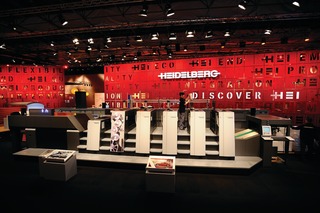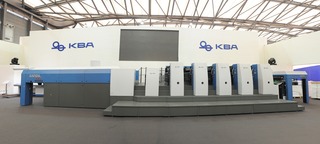Offset Printing Trends
There’s no arguing the numbers; the offset printing market is shrinking. Shrinking is not the same as disappearing, however.

There’s no arguing the numbers; the offset printing market is shrinking.
Among other data, a 2013 Smithers Pira study, called “The Future of Offset vs. Digital Printing to 2018,” states, “The volume of all offset prints will have fallen by 10.2 percent across the world between 2008 and 2018, while digital print volume is forecast to grow by 68.3 percent.”
Shrinking is not the same as disappearing, however.
The worldwide market for offset presses continues to diminish at a small percentage each year, particularly in the small and half-size market where digital presses are having their greatest impact, acknowledged Eric Frank, KBA vice president of marketing. “However, the 41-inch and large format markets are still strong, due to efficiencies that these presses yield.”
Printers are using both digital and offset, added Frank, “but still leaning toward offset for the highest of quality special effects, and to utilize unique strengths, but digital certainly has its strength as well.”
In the US market, commercial printers are busy, packaging printers are busy, and label printers are busy, added Andy Rae, senior vice president - equipment, Heidelberg. “The offset press still delivers the best margins for any of those segments.”
“We believe there is a need for offset, digital, and inkjet,” said Clarence Penge, VP sheetfed product management, Heidelberg. “But if you look at the crossover point between offset and digital, with today’s presses, the crossover in the 29-inch market is really 250 sheets.
“If you are trying to compete with presses from the 1980s, then the crossover point from offset to digital is 3,000 sheets,” he added. “But for new presses, the crossover point is 250.”
KBA and Heidelberg are reporting strong sales, as customers look to replace aging presses with highly automated presses that run like champion thoroughbreds, at speeds unheard of 10 years ago. In the weeks leading up to GRAPH EXPO 15, Heidelberg reported 80 new sheetfed units sold across all market segments over a six-week period, noted Rae. In third-quarter 2015, KBA reported that all of its divisions posted a double-digit rise in volume for new orders.
A press with advanced automation features, offering higher quality, more efficient make-ready, and faster speeds, is able to replace up to three presses built 20 years ago. For short-run projects, these highly advanced presses can produce 100 jobs in an eight-hour shift, compared to the 15-20 jobs that was once the norm.
Just recently, commercial and packaging printer Imagine! Print Solutions, completed its installation of a new KBA Rapida 105 41-inch seven-color press at its Shakopee facility, outside of Minneapolis. Configured with seven colors plus coater and KBA VariDry UV system, as well as a KBA inline color control system, the press, the new Rapida replaces two older presses, adding 50 percent more productivity.
Ten to 15 years ago, Heidelberg’s Speedmaster press had a throughput of 26 million sheets annually; today’s current crop of XL presses produce between 40 to 90 million sheets annually, said Rae.
In Cleveland, Jakprints, Inc. installed a Speedmaster XL 75 Anicolor press in May, moving from two presses to one with a 30 percent increase in production capacity and anticipated savings of up to one million sheets for the year.
Four months into production, the company’s XL 75 Anicolor can be set up to print coated or textured paper, board, or envelopes in five to 10 minutes, with only 20 to 30 waste sheets, depending on the job. With a “typical” job in the range of 500-1,000 sheets, the company can run 20 to 30 jobs a day over three shifts, including jobs in the tens of thousands, demonstrating that the XL 75 Anicolor can be exploited over both short and long runs.
New press enhancements also help reduce costs. “One of the highest costs of printed products is the substrate, and new make-ready features address this directly, helping to reduce waste during startup,” explained Frank. “In terms of being green, there’s also drying enhancements such as LED UV that use less electricity; and there many sub components in offset presses that are now focused on reduced energy costs and usage.”
DavCo’s newest addition, the Ryobi 924, installed spring 2014 at its Kinzers, PA facilitiy, is equipped with a host of standard and optional features, including a semi-automatic plate loader, an ink volume setter, the Ryobi PCS-G Printing Control System, auto-cleaning devices, and the SMART Makeready function, all of which reduce make-ready time. It also has a Harris & Bruno International aqueous coater and the Pamarco Global Graphics Sentinel Ink Management System, an electronically controlled, fully automated, air-tight cartridge ink dispensing system that also tracks and reports ink usage.
For commercial offset printers, survival and success demand improving process efficiencies and finding ways to add value to print.
One ongoing struggle for the commercial printer is to move away from the job shop mentality, said Penge.
This requires a shift in how the process is viewed, and to not look at the various functions – prepress, press, and postpress –as separate parts of the process, but instead as part of an integrated system.
To that end, the concept Heidelberg promotes to its customers the print shop as a process-controlled, manufacturing environment.
When we sell a press, it doesn’t just end there, said Penge. “We operate as a business consultancy; to help the customer realize capacity, maximize output, solve bottlenecks. We are helping them to understand their costs, so for instance, they don’t take a job on that causes bottlenecks or isn’t generating a profit.”
This approach is becoming standing operating procedure for press manufacturers, who are vested in their customers’ success. Also de rigeur are programs that maximize the productivity and performance of the customer’s advanced press, such as KBA Service Select.
Preventative service is also a big part what we are offering, said Frank. “Machines can predict downtime in advance, and there is additional OPE analysis for measuring productivity. In addition, we are offering training of second and third shift crews; general training and education throughout lifecycle of press, not just the first year.”
Automation is also a big discussion with new press buys as it greatly helps increase the printer’s’ profitability. “Closed loop automation systems that are self-maintaining, for example, help printers ensure consistent quality during the run, thus ensuring a satisfied and returning customer,” said Frank.
He also noted there a lot of requests for ROI analysis to justify the additional cost of automation, which is being purchased in greater capacity than ever before. In line register, in-line color control, presetting of jobs prior to job coming on press to save time on press—all are on add-ons that have to be justified in terms of throughput and efficiencies to pay for it.
Another trend in the U.S. market, specifically within the packaging arena, is the custom-configured offset press, said Rae. The machines are built to take on the jobs in the most efficient way possible, reducing material waste and job setup time.
In Niles, IL, JohnByrnes is running a 15-unit Heidelberg Speedmaster XL 106, designed from scratch. Dubbed Press384, and called a “concept” press, it is configured with three coating units, eight print units, and four dryers, enabling the company to execute virtually any “coat-print-coat-print-coat-dry” combination at speeds up to 18,000 sheets per hour. Among other characteristics, the press, which stretches almost 130 feet long and with a format size of 29x41, has an upfront coater to disperse flexographic white, metallic, or pearl coatings, and to create barrier properties for plastic, Mylar and exotic substrates. Two dryer units are placed after the up-front coater to cure UV coatings at high press speeds, and second and third coaters are designated for UV or aqueous, grit, soft touch, pearl, silver, gold and particulate coatings.
In September, leading New York pharmaceutical, cosmetic, and over-the-counter packaging supplier Beyer Graphics placed an order for two new KBA Rapida 106 41-inch UV presses. The custom-designed Rapida 106 nine-color press, scheduled for February 2016 installation, is configured with eight printing units plus a coater, then two drying units plus another printing unit followed by another coater and a 12-ft extended delivery.
“We see more and more offset printers printing on different substrates; such as foils, plastic, fluted substrates, etc. that help them standout from the crowd; this along with the use of more spot colors, coatings, such as gloss dull matte soft touch are enabling this,” Frank said.
The growth of UV technology, not only in labels and packaging but also in the commercial segment, is a major factor in the increase in the type of substrates being used. UV technology allows PSPs to print on a broad range of materials, including clear plastics, metalized papers, and synthetics, while shrinking drying time. Also UV coatings also allow for greater flexibility.
UV is becoming commonplace in all its forms – traditional UV; HR- UV; and LED-UV, said Frank. “Each produce a rounder, firmer dot and enable immediate finishing capabilities,” he added.
Premier Print Group in Champaign, IL just purchased its third Komori press, an eight-color Lithrone G40 perfector with H-UV. The company plans to expand its offerings, using the capabilities of the H-UV to print on difficult stocks, like uncoated or matte, without worrying about marking and scuffing or to create special effects with all types of glosses and reticulating varnishes.
In today’s market, you don’t go UV because you have a marking problem; you go UV because you have the application for it, said Penge. “You use it as a value add,” he noted.
Traditional UV remains the most popular, but LED is seen as the wave of the future.
Still another trend is the demand for long perfectors, which until recently had waned. “But due to new enhanced features, they are becoming more and more popular again,” Frank said. “Printers are working ever closer with designers, who are looking to have their brochure or package stand out in a crowded environment; by using a long perfector in straight mode, they are incorporating more Pantone colors for a stronger printed product.”
Nor will the enhancements end, with drupa right around the corner. Expect to see a “plethora of enhancements that will make an offset press even more viable,” said Frank. These include closed-loop systems, in-line finishing capabilities, and longer press configurations in commercial and packaging.


